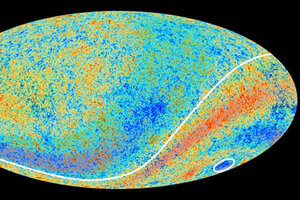The largest structure in the universe is a whole lot of nothing, astronomers say
Researchers believe they have discovered the largest known structure in the universe, a 'supervoid' measuring some 1.8 billion light years across.

A partial image from the Planck telescope, with cold spot circled.
ESA and the Planck Collaboration
Researchers have discovered the largest known structure in the universe, but it isn’t really a thing so much as it is an absence.
Described last week by an international team of astronomers in last week in the Monthly Notices of the Royal Astronomical Society, this 'supervoid' spans 1.8 billion light years across, making it perhaps the largest single structure known to humanity. But compared to the rest of the universe, it is remarkably empty.
The supervoid corresponds with a cold spot in the radiation left over by the Big Bang called the cosmic microwave background (CMB). As data from European Space Agency’s Planck observation mission show, the CMB is not uniform, with hot and cold 'patches.' But astronomers have struggled to explain the sheer size of this particular cold spot, which was first identified in 2004.
Previous investigations of the cold spot had found no voids in that direction. But as it turns out, astronomers just needed to look a little closer to home.
István Szapudi, of the University of Hawaii at Manoa, led a targeted astronomical survey, believing the cold spot to be a result of a large void. Using Hawaii’s Pan-STARRS1 (PS1) telescope and NASA’s Wide Field Survey Explorer (WISE) satellite, Dr. Szapudi’s team observed a relatively close patch of sky from 3 billion light years away. It was there they found a huge gap where some 10,000 galaxies ought to have been.
The supervoid isn’t a vacuum in the traditional sense. It isn’t totally empty, rather it contains about 20 percent less matter than most parts of the universe. It represents a large and inexplicably homogenous region of a universe that is, for the most part, evenly distributed.
“The void itself I’m not so unhappy about. It’s like the Everest of voids – there has to be one that’s bigger than the rest,” co-author Carlos Frenk, of Durham University, told the Guardian. “But it doesn’t explain the whole cold spot, which we’re still in the dark about.”
But while the supervoid doesn’t solve the cold spot problem, it does provide a possible – if partial – explanation.
Imagine a ball rolling up a hill. As the ball approaches the peak of the hill, it slows down, losing kinetic energy but gaining potential energy. As it crests the hill, gravity pulls it down on the other side, and it regains kinetic energy and loses potential energy.
All else being equal, something similar should happen to a photons as they pass through a void. As light leaves a denser region of the universe, which exerts a gravitational pull, it loses kinetic energy, not slowing down in this case, but increasing in wavelength and cooling. But as they approach the denser region on the other side of the void, they should regain that energy.
But that's not what actually happens, because, as the light made its way though the void, the universe expanded, preventing the light from converting all of its potential energy back into kinetic energy.
And if the supervoid and cold spot are correlated, it could support the accelerating universe theory – the notion that the universe is expanding at an increasing rate. Cosmologists have attributed that effect to “negative pressure” from dark energy.
“This is independent evidence, in case anyone doubts it, for the existence of dark energy,” Frenk told the Guardian.

